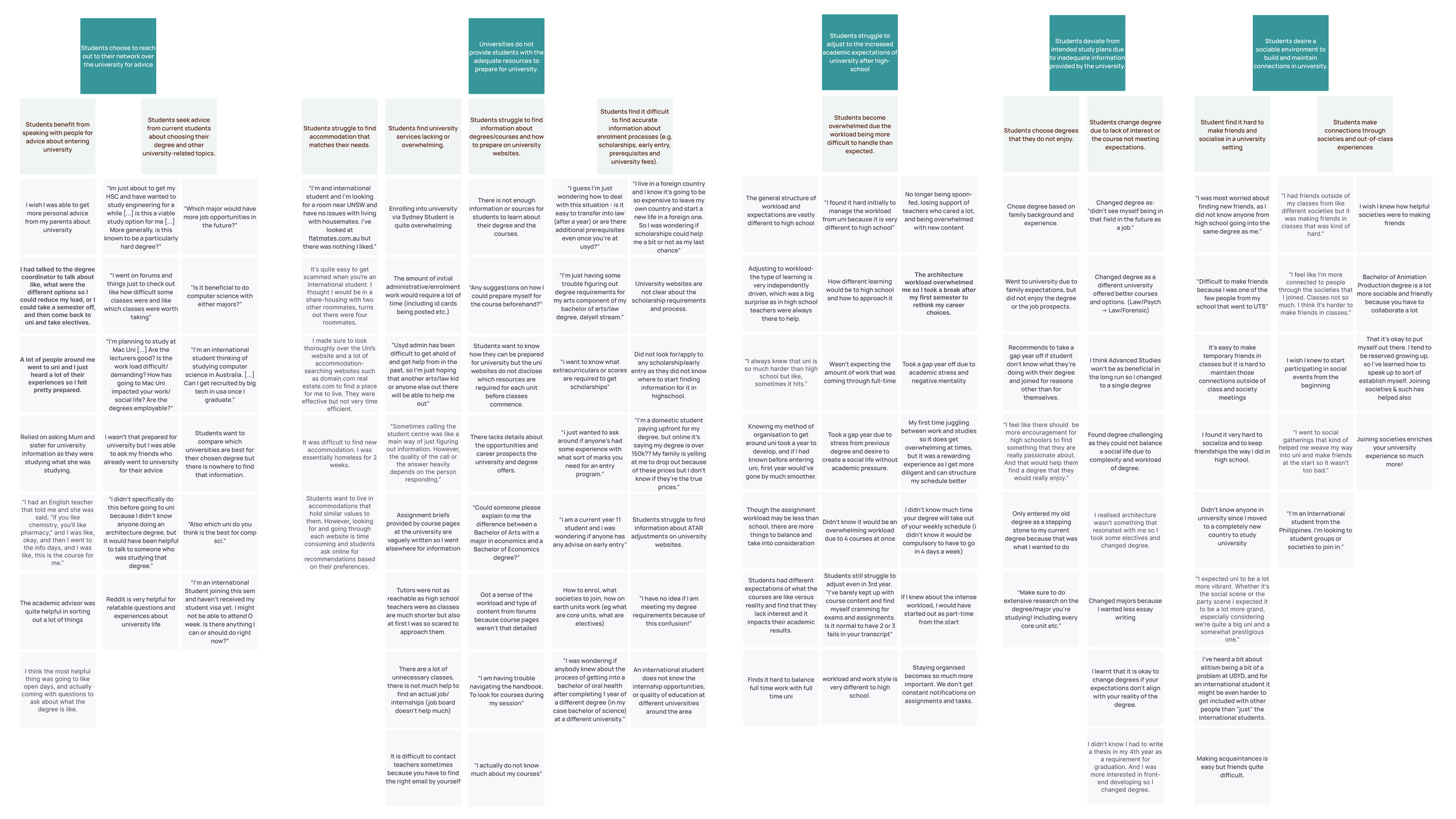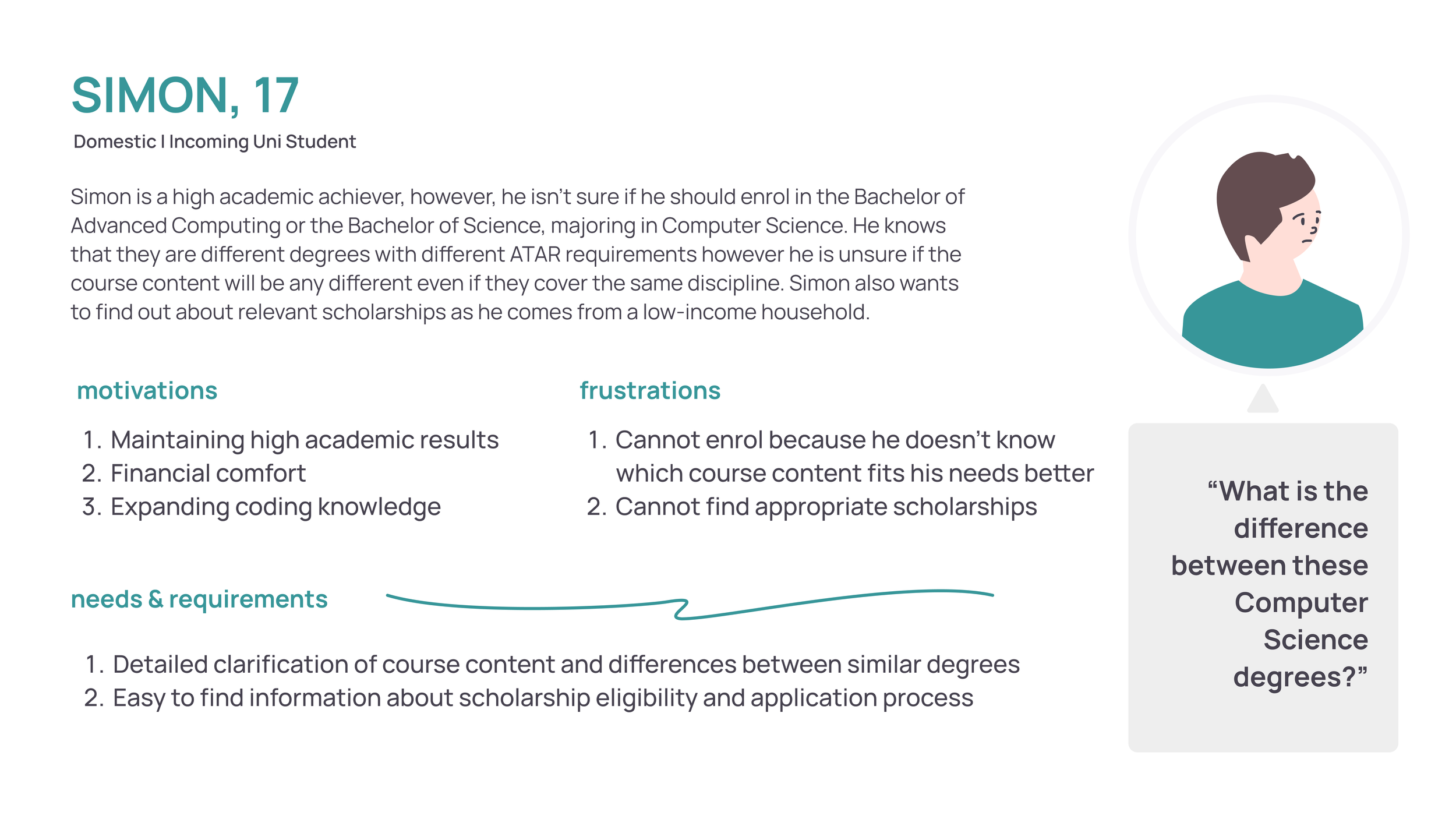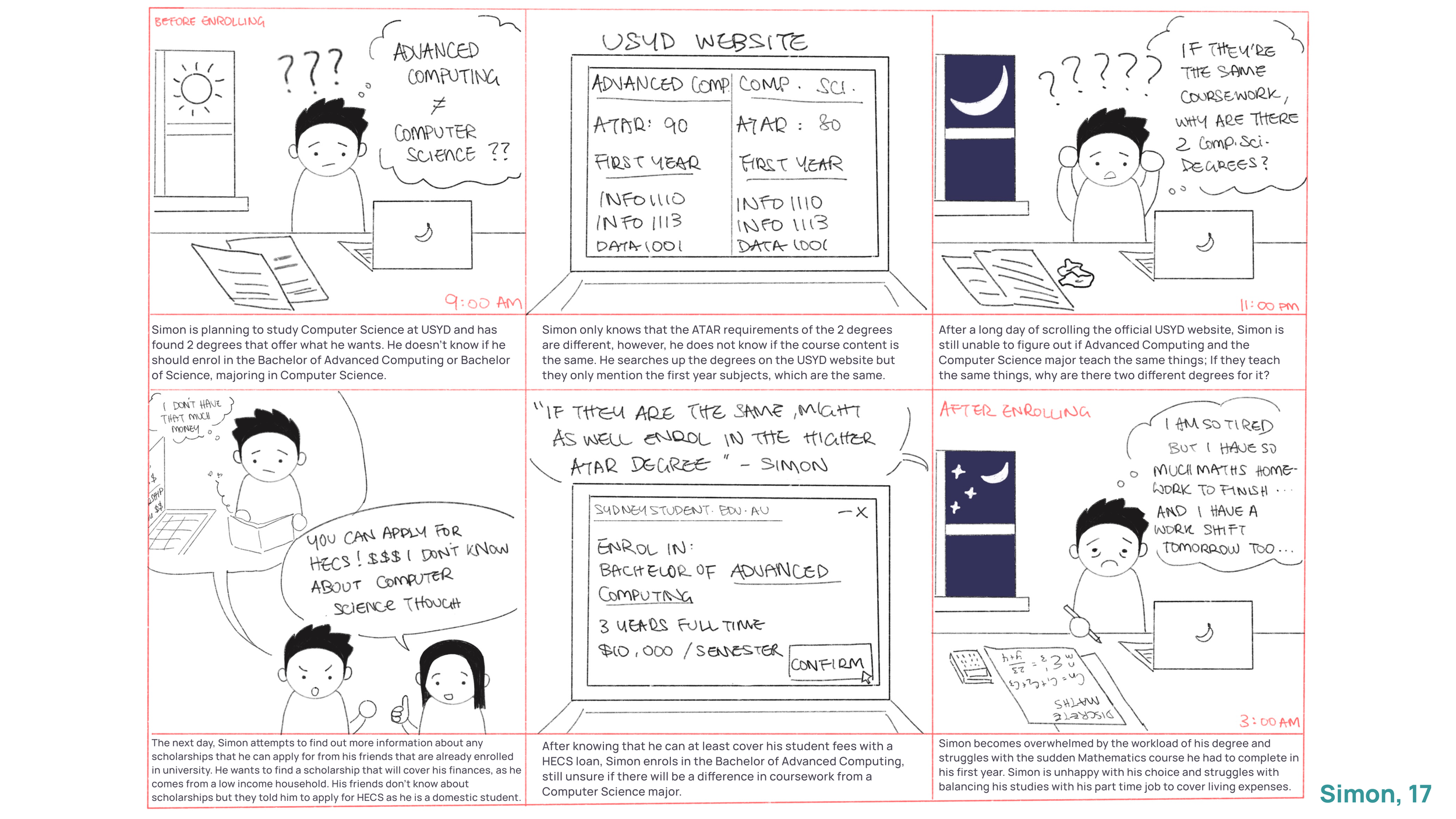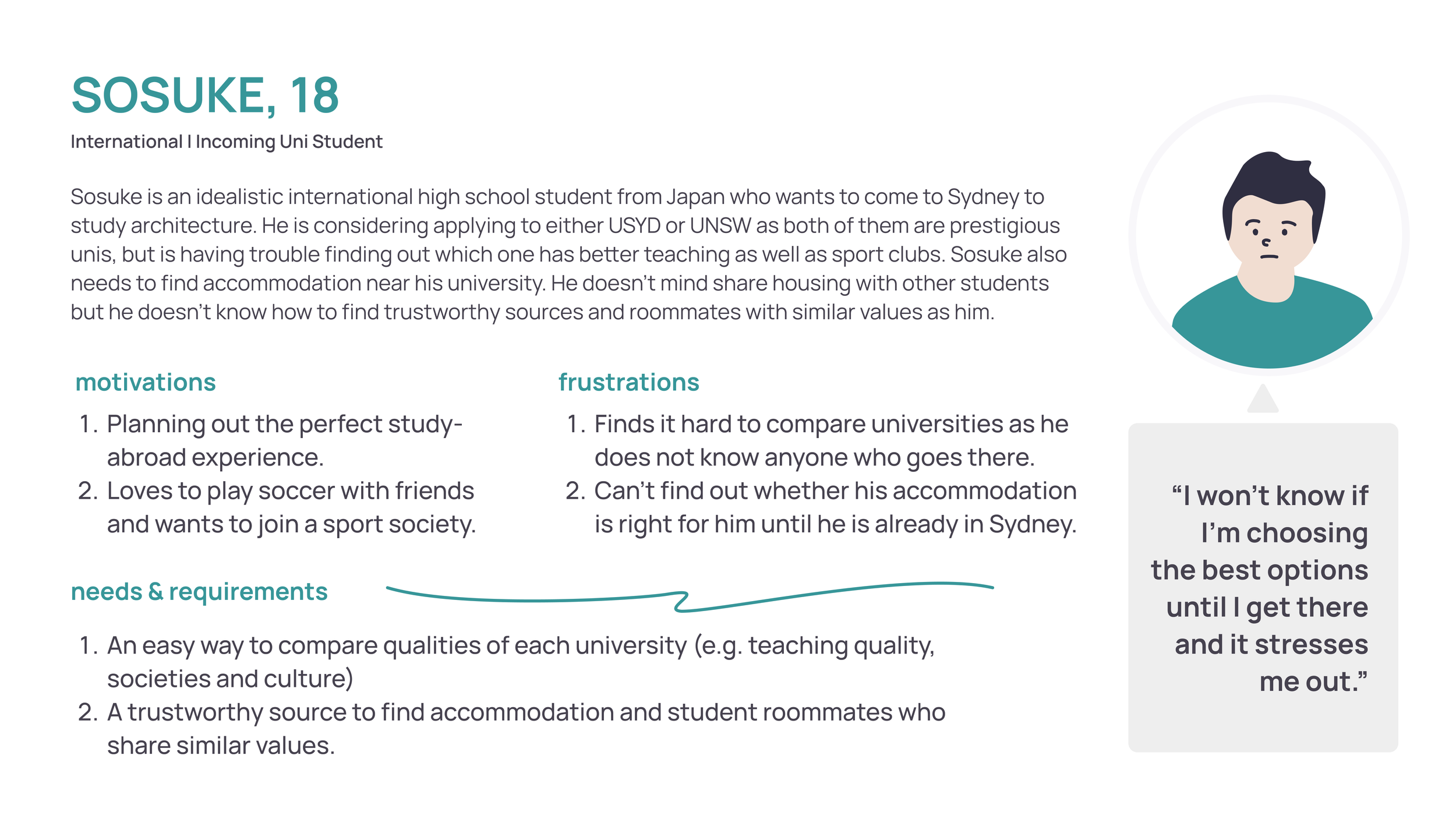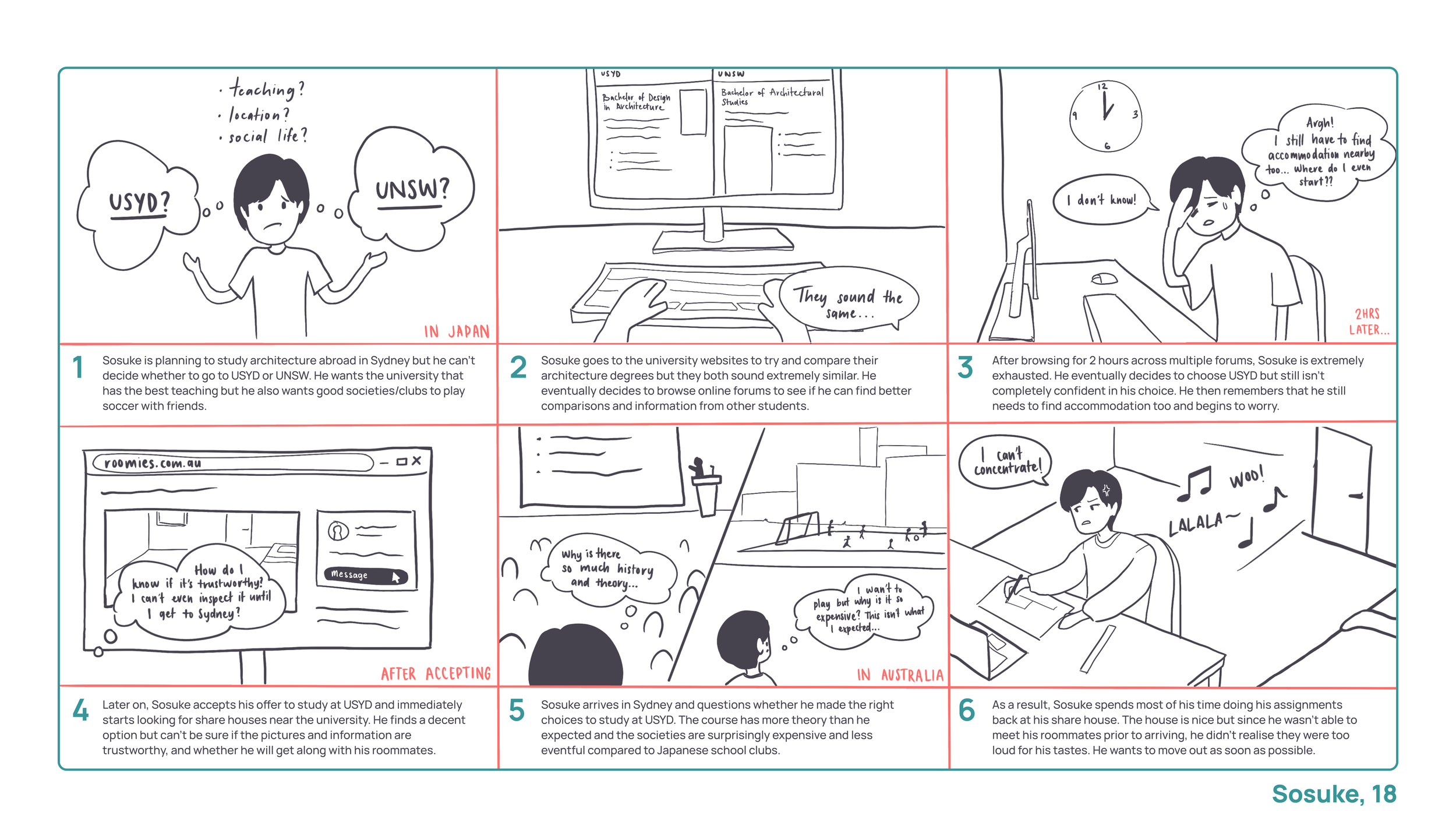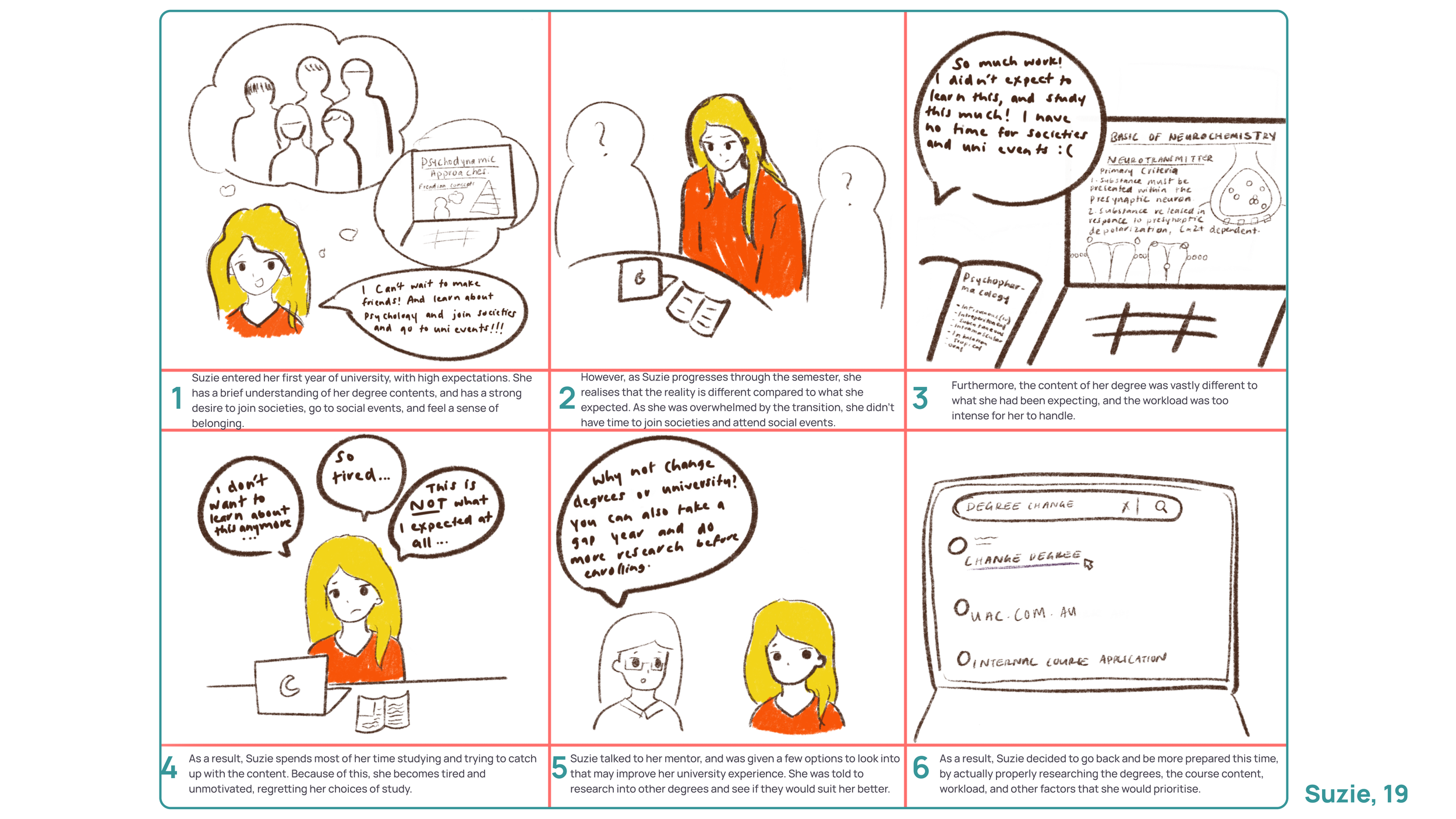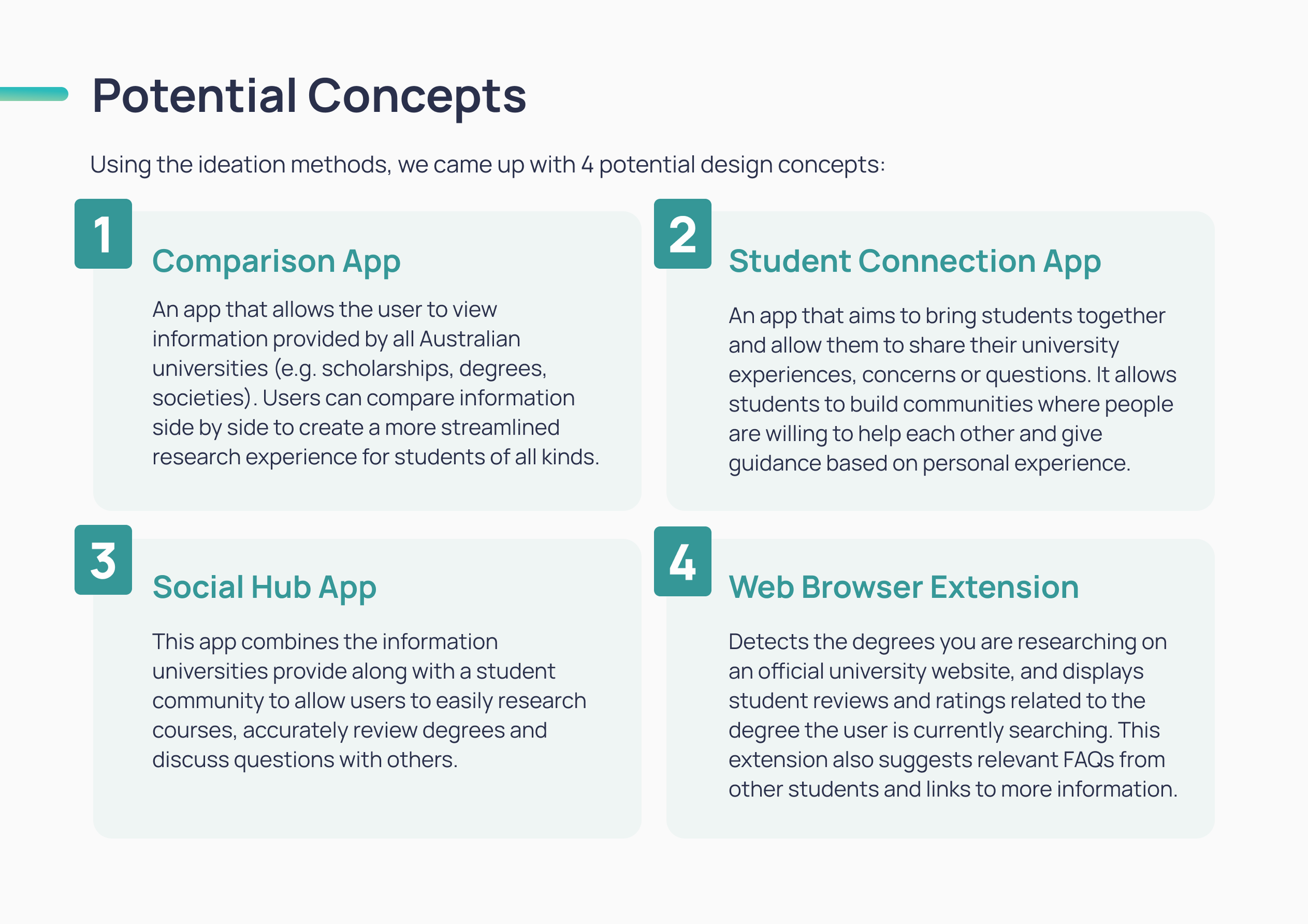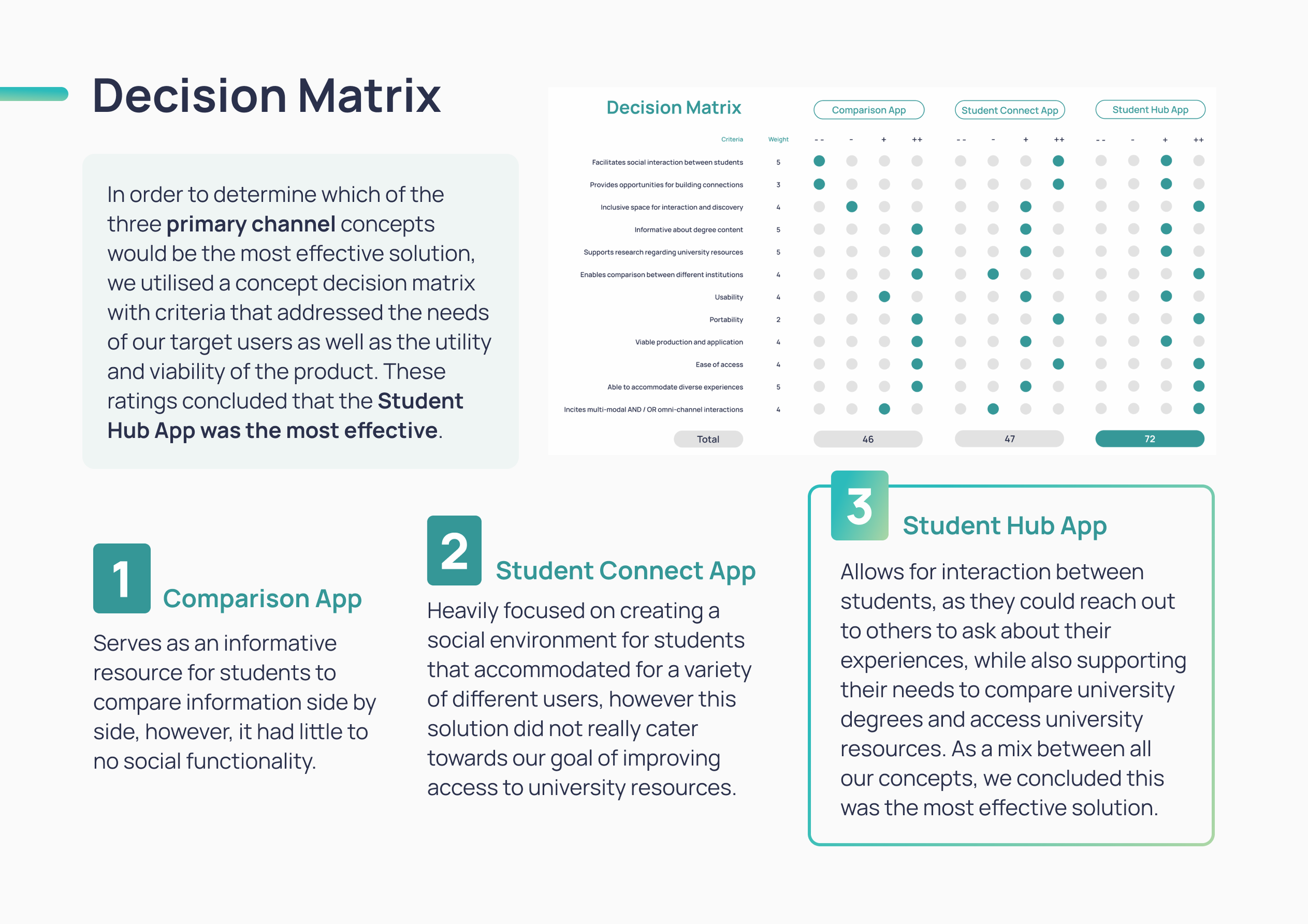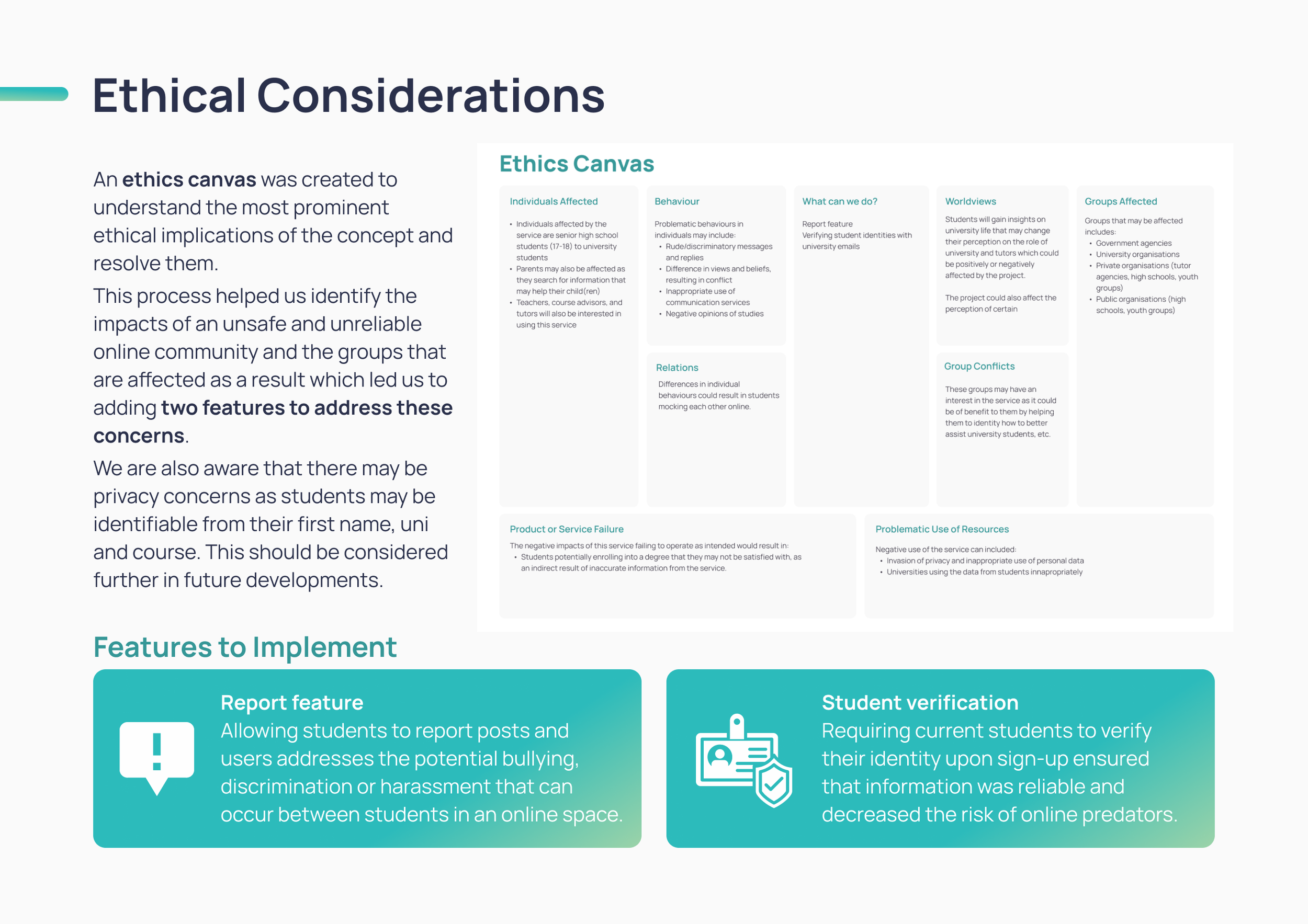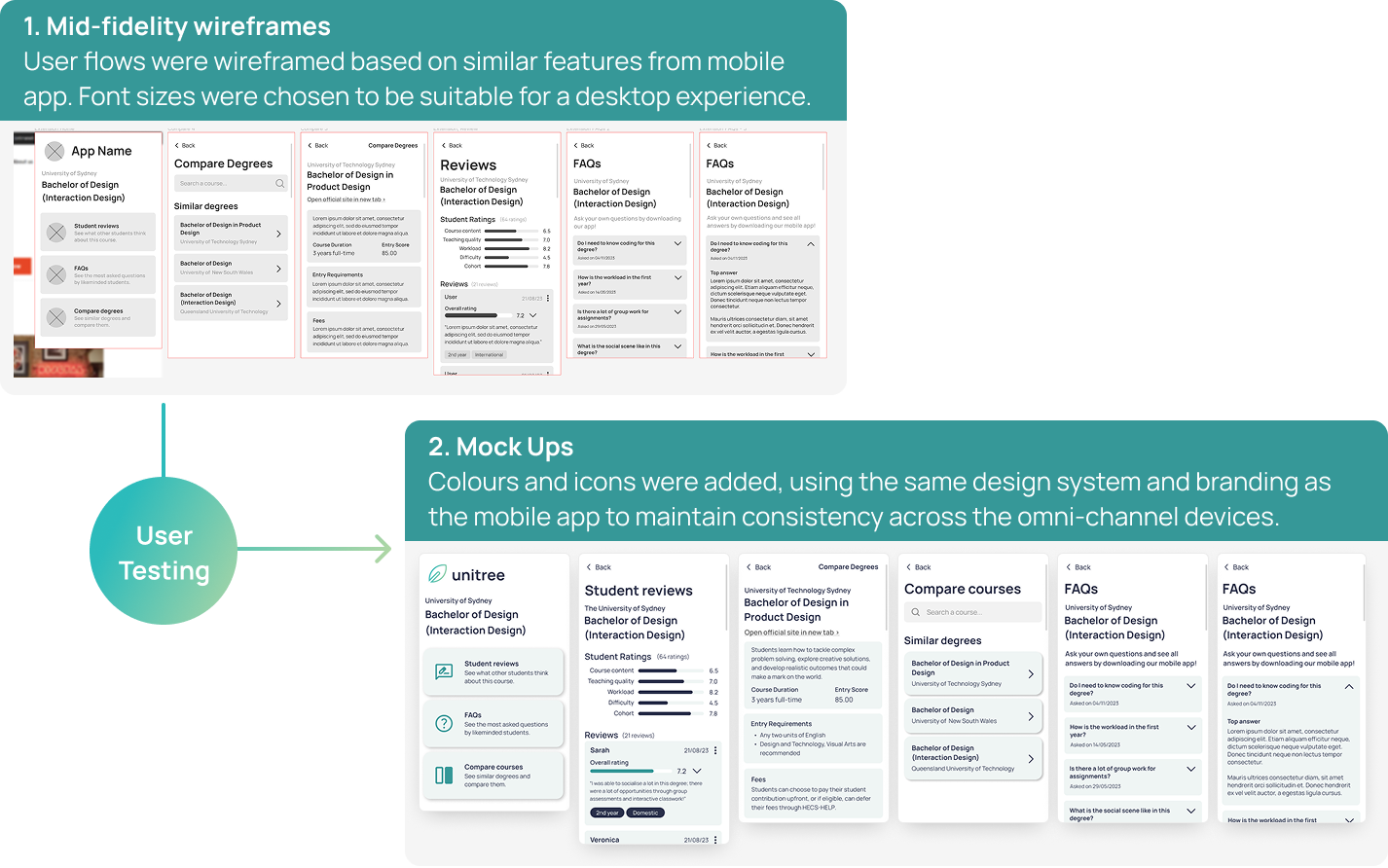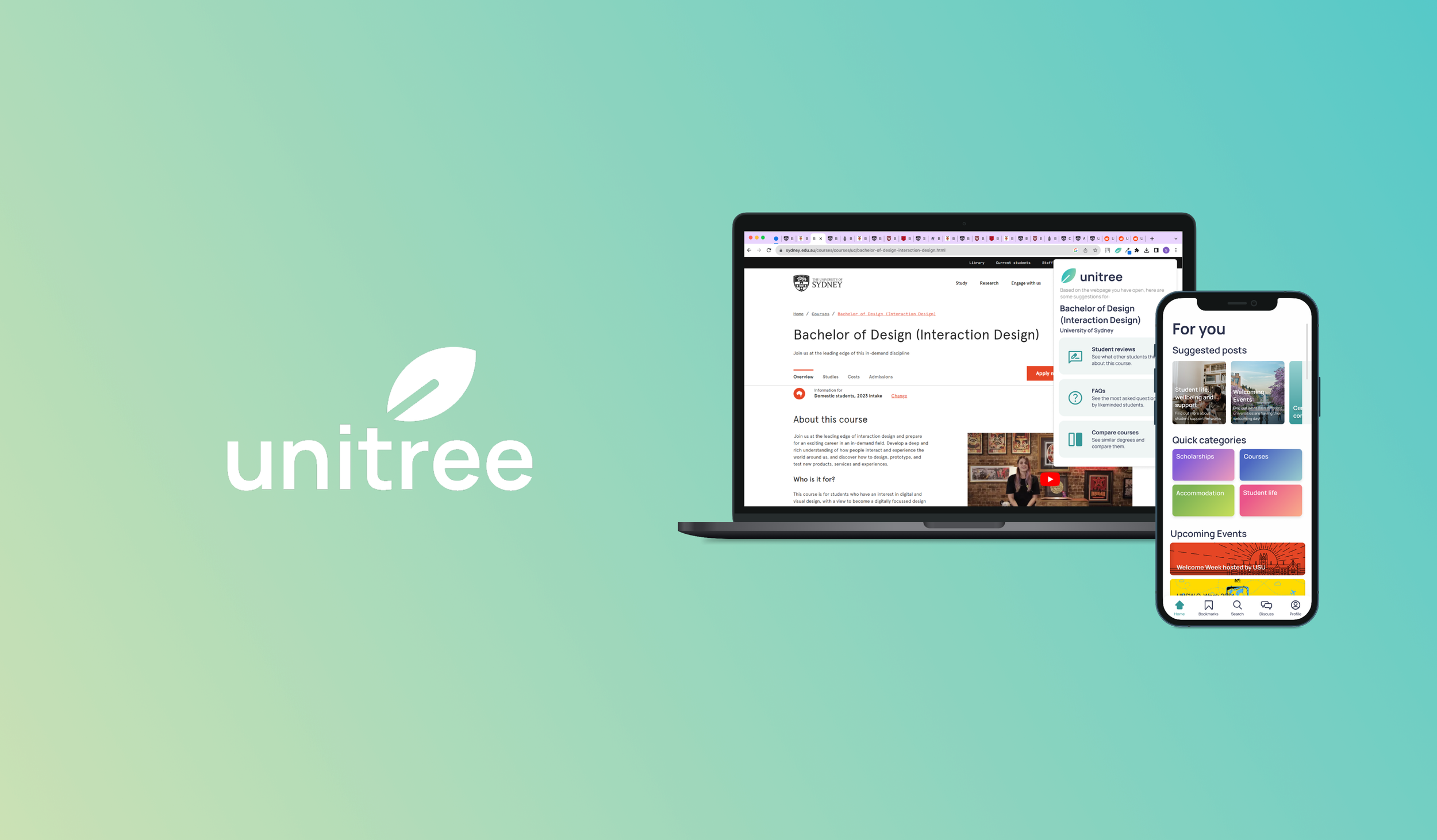
Overview
Unitree is an omni-channel application designed to foster connection and interaction between students, to reach out to others to seek information regarding their experiences, while also supporting their needs to compare university degrees and access university resources.
The transition from high school to university is a life-changing time as students must learn to manage their time and effort independently. While some students successfully adjust to university life, many students do not, often resulting in attrition from the university and mental health issues. Our team decided to focus on this area by designing a platform that enhances student support and fosters a sense of belonging. We recognised that access to shared experiences, guidance, and university resources could help ease the transition, ultimately improving student retention and well-being.
Duration | August 2023 - November 2023
Role | UX/UI designer, UX researcher
Tools | Figma
Team | Sarah Dang, Veronica Lee, Tavania Santoso
Final solution
Promotional Video
Improving the transition from high school to university.
Problem Area
Context
We were influenced by our personal experiences of struggling to adjust during COVID-19 lockdowns and noted that more could have been done to prepare us for the change in academic environments. From this, we chose to conduct further research on the transition between high school and university.
The transition from high school to university is a crucial period and life-changing time for the majority of students where they must learn how to manage their time, effort, and finances independently. An article highlights the high occurrence of stressors that students face in their transition to university which “often results in attrition from the university and mental health issues”. Another study found that students had unrealistic expectations about the potential academic difficulties they would encounter, which affected their learning experience.
We also found that more than a fifth of students leave university prior to finishing their degree and nearly 40% of students who dropped out “would not begin their degree again knowing what they know now”.
Primary Research
We applied triangulation to ensure a comprehensive and reliable understanding of the problem by integrating insights from multiple research methods. A questionnaire with 17 exploratory questions gathered statistical data from 42 participants, helping refine key research topics. Semi-structured interviews with nine participants (aged 18–21) provided in-depth qualitative insights into university transition challenges and effective support methods. Additionally, online ethnography analysed behavioural patterns on Reddit, examining 36 posts across three university subforums to identify common student concerns. This multi-method approach strengthened the validity and depth of our findings.
Data Analysis
Through affinity diagramming, we were able to categorise our leanings from our qualitative data, identifying themes and drawing insights. Based on the learnings and insights identified, we formed three personas that help link together and communicate the user’s goals, motivations, attitudes, and behaviours. Personas and storyboards will assist us in ideating experiences based on our key insights from the affinity diagram.
Key insights
1
2
3
4
5
Students are more inclined to reach out to their own networks for advice about the university as university-provided sources were not sufficient.
Students sought out knowledge from friends, online forums and advisors to gain a better understanding of university life. This leads us to understand that students benefit more from personally curated advice that answers directly to their concerns.
Universities do not provide adequate resources for students to prepare for university.
24 out of 36 online ethnography entries mentioned student’s struggles with finding appropriate resources about degrees, scholarships, and course content. This suggests that there are not enough appropriate resources about the degrees, or that it is not easily accessible for students.
Students struggle to adjust to the increased academic expectations of university life after high school.
43% of participant responses in the questionnaire stated that the workload did not match their expectations, with only 28.5% of participants feeling that high school prepared them with the skills to manage university workloads
Students deviate from intended study plans due to their expectations not being met.
This aligned with our background research where more than 1/5 of students who started a Bachelor's degree left university without completing the degree. 33.3% of survey respondents had a degree transfer due to reasons such as change of interest, difficult workloads and unexpected course content.
Students desire a sociable environment to build and maintain connections in the university.
47.6% of survey respondents answered that they found it difficult to make friends and find a sense of community at university.
Based on primary research, the initial problem statement was validated and refined to better align with the needs of our user base, ensuring a more tailored and effective foundation for designing the solution.
Refined problem statement:
A large number of students do not end up completing their original degree due to the disparity between expectations and reality, leaving students overwhelmed by the transition from high school to university.
Students need a centralised, accessible and accurate source of information to better help them make informed decisions about their academic pursuits.
Ideation
Utilising a combination of a reframed user journey map, mind mapping, Crazy 8’s and storyboarding, we formed the early design concepts that aligns to our research. Visually forming our ideas encourages us to think creative and to focus purely on our problem space.
How did our concept addresses the problem?
Our design addresses four of the five key insights from our user research:
Insight 1 | Users are able to easily reach out to the right communities for relevant advice about university.
Insight 2 | Users are provided with additional resources and centralises existing info from uni websites.
Insight 3 | The app helps users form realistic expectations about workload/lifestyle in university
Insight 4 | The app targets users that have not started uni yet, to help prevent regrets in their future study plans
Social interaction | The need for students to gain insights and advice from other students was evident from our research, therefore building a community for people to express their concerns or experiences was vital. We believed the primary channel (mobile app) was ideal to facilitate social interaction as it would be easily accessible and could provide instant notifications to students.
Omni-channel | For the secondary channel, we initially planned to make a desktop website with the same mobile features, however, we realised this solution would not be sufficient to replace the traditional method of browsing through many university websites. Thus, we decided to enhance the existing experience with a web extension that could detect the university course that the students were currently looking at, and provide a condensed version of the core functionalities of the mobile app.
Mobile app iteration
Concept sketches to mid-fidelity wireframes
Mock ups refinement
Web extension iteration
Mid-fidelity usability testing
We employed two user testing methods—user-based think-alouds and expert-based cognitive walkthroughs—to identify usability issues in our wireframes. To analyse the collected data, we annotated transcripts from both methods, highlighting usability goals and feedback. These insights were then synthesised using a top-down affinity diagram. Additionally, we created a usability testing insights table to systematically organise findings, evaluate feature performance based on completion rates, and assign severity ratings to prioritise improvements.
Feedback: Usability testing showed strong performance, with 9 out of 11 features achieving a 100% completion rate. Key pain points included account creation, posting questions, and profile updates, which became our priority for refinement.
Wireframes to Prototypes
Prototype usability testing
We used a sequential testing approach with three prototype iterations. The first was tested through seven expert-led heuristic evaluations, helping us identify critical usability issues. Based on that feedback, we refined the prototype and conducted a second round of unmoderated user testing via Loop11. A pilot test ensured clarity in task scenarios, and the method offered flexibility and automated analysis, aligning usability with user needs.
SUS survey results
Users found the prototype intuitive and well-integrated, earning an SUS score of 85/100.
Final Prototype Overview
Reflection
Our design process was both challenging and rewarding, allowing us to refine usability testing methods such as cognitive walkthroughs, heuristic evaluations, and Loop11. Through this project, we gained valuable insight into the challenges university students face when transitioning from high school, making the experience both meaningful and impactful.
User feedback strongly validated our research, with participants expressing enthusiasm for the app and its potential benefits. A high System Usability Scale (SUS) score reinforced the effectiveness of our design, highlighting its usability and real-world potential.
Future steps
To balance credibility with privacy, we plan to introduce granular privacy controls, allowing users to manage their profile visibility. By implementing default privacy settings, user information will remain private unless they choose to share it. Additionally, replacing first names with usernames will maintain anonymity while still ensuring identity verification.
Beyond privacy improvements, expanding the app’s utility will enhance user engagement. Students will have the ability to follow discussion boards based on their interests, customising their Discuss page with relevant content. To further support incoming students, a mentorship program will connect them with experienced peers or alumni, providing personalised guidance and fostering a smoother transition into university life.
We achieved a high distinction for this assignment ✨


